class: center, middle, inverse, title-slide # Minimal Galton Board ### Gina Reynolds ### 6/29/2019 --- ```r source("https://raw.githubusercontent.com/EvaMaeRey/little_flipbooks_library/master/xaringan_reveal_parentheses_balanced.R") ``` ```r library(tidyverse) options(gganimate.nframes = 400, scipen = 10) ``` --- # Define paramters ```r n <- 70 # number of ball bearnings stop_level <- 10 # number of perturbation levels # make it an even number levels <- 44 # greater than stop_levels ``` --- # Write some code to describe the random-walk of ball bearings --- --- class: split-40 count: false .column[.content[ ```r *set.seed(2019) ``` ]] .column[.content[ ]] --- class: split-40 count: false .column[.content[ ```r set.seed(2019) *crossing(unit_id = 1:n, * level = 1:levels - 1) ``` ]] .column[.content[ ``` # A tibble: 3,080 x 2 unit_id level <int> <dbl> 1 1 0 2 1 1 3 1 2 4 1 3 5 1 4 6 1 5 7 1 6 8 1 7 9 1 8 10 1 9 # … with 3,070 more rows ``` ]] --- class: split-40 count: false .column[.content[ ```r set.seed(2019) crossing(unit_id = 1:n, level = 1:levels - 1) %>% * mutate(perturbation = # moves * sample(c(-1,1), # left or right * n(), # each ball at each level * replace = T)) ``` ]] .column[.content[ ``` # A tibble: 3,080 x 3 unit_id level perturbation <int> <dbl> <dbl> 1 1 0 1 2 1 1 1 3 1 2 -1 4 1 3 1 5 1 4 -1 6 1 5 -1 7 1 6 1 8 1 7 -1 9 1 8 -1 10 1 9 1 # … with 3,070 more rows ``` ]] --- class: split-40 count: false .column[.content[ ```r set.seed(2019) crossing(unit_id = 1:n, level = 1:levels - 1) %>% mutate(perturbation = # moves sample(c(-1,1), # left or right n(), # each ball at each level replace = T)) %>% * group_by(unit_id) # operations on each ball ``` ]] .column[.content[ ``` # A tibble: 3,080 x 3 # Groups: unit_id [70] unit_id level perturbation <int> <dbl> <dbl> 1 1 0 1 2 1 1 1 3 1 2 -1 4 1 3 1 5 1 4 -1 6 1 5 -1 7 1 6 1 8 1 7 -1 9 1 8 -1 10 1 9 1 # … with 3,070 more rows ``` ]] --- class: split-40 count: false .column[.content[ ```r set.seed(2019) crossing(unit_id = 1:n, level = 1:levels - 1) %>% mutate(perturbation = # moves sample(c(-1,1), # left or right n(), # each ball at each level replace = T)) %>% group_by(unit_id) %>% # operations on each ball * mutate(perturbation = * ifelse(row_number() == 1, * yes = 0, # start centered * no = perturbation)) ``` ]] .column[.content[ ``` # A tibble: 3,080 x 3 # Groups: unit_id [70] unit_id level perturbation <int> <dbl> <dbl> 1 1 0 0 2 1 1 1 3 1 2 -1 4 1 3 1 5 1 4 -1 6 1 5 -1 7 1 6 1 8 1 7 -1 9 1 8 -1 10 1 9 1 # … with 3,070 more rows ``` ]] --- class: split-40 count: false .column[.content[ ```r set.seed(2019) crossing(unit_id = 1:n, level = 1:levels - 1) %>% mutate(perturbation = # moves sample(c(-1,1), # left or right n(), # each ball at each level replace = T)) %>% group_by(unit_id) %>% # operations on each ball mutate(perturbation = ifelse(row_number() == 1, yes = 0, # start centered no = perturbation)) %>% * # each ball should release one at a time * mutate(time = # displacing them in time w/ * row_number() + * # using unit id * unit_id * 3 - 1) ``` ]] .column[.content[ ``` # A tibble: 3,080 x 4 # Groups: unit_id [70] unit_id level perturbation time <int> <dbl> <dbl> <dbl> 1 1 0 0 3 2 1 1 1 4 3 1 2 -1 5 4 1 3 1 6 5 1 4 -1 7 6 1 5 -1 8 7 1 6 1 9 8 1 7 -1 10 9 1 8 -1 11 10 1 9 1 12 # … with 3,070 more rows ``` ]] --- class: split-40 count: false .column[.content[ ```r set.seed(2019) crossing(unit_id = 1:n, level = 1:levels - 1) %>% mutate(perturbation = # moves sample(c(-1,1), # left or right n(), # each ball at each level replace = T)) %>% group_by(unit_id) %>% # operations on each ball mutate(perturbation = ifelse(row_number() == 1, yes = 0, # start centered no = perturbation)) %>% # each ball should release one at a time mutate(time = # displacing them in time w/ row_number() + # using unit id unit_id * 3 - 1) %>% * filter(time > 0) ``` ]] .column[.content[ ``` # A tibble: 3,080 x 4 # Groups: unit_id [70] unit_id level perturbation time <int> <dbl> <dbl> <dbl> 1 1 0 0 3 2 1 1 1 4 3 1 2 -1 5 4 1 3 1 6 5 1 4 -1 7 6 1 5 -1 8 7 1 6 1 9 8 1 7 -1 10 9 1 8 -1 11 10 1 9 1 12 # … with 3,070 more rows ``` ]] --- class: split-40 count: false .column[.content[ ```r set.seed(2019) crossing(unit_id = 1:n, level = 1:levels - 1) %>% mutate(perturbation = # moves sample(c(-1,1), # left or right n(), # each ball at each level replace = T)) %>% group_by(unit_id) %>% # operations on each ball mutate(perturbation = ifelse(row_number() == 1, yes = 0, # start centered no = perturbation)) %>% # each ball should release one at a time mutate(time = # displacing them in time w/ row_number() + # using unit id unit_id * 3 - 1) %>% filter(time > 0) %>% * mutate(x_position = # we get the x position * # by summing the cumulative distributions * cumsum(perturbation)) ``` ]] .column[.content[ ``` # A tibble: 3,080 x 5 # Groups: unit_id [70] unit_id level perturbation time x_position <int> <dbl> <dbl> <dbl> <dbl> 1 1 0 0 3 0 2 1 1 1 4 1 3 1 2 -1 5 0 4 1 3 1 6 1 5 1 4 -1 7 0 6 1 5 -1 8 -1 7 1 6 1 9 0 8 1 7 -1 10 -1 9 1 8 -1 11 -2 10 1 9 1 12 -1 # … with 3,070 more rows ``` ]] --- class: split-40 count: false .column[.content[ ```r set.seed(2019) crossing(unit_id = 1:n, level = 1:levels - 1) %>% mutate(perturbation = # moves sample(c(-1,1), # left or right n(), # each ball at each level replace = T)) %>% group_by(unit_id) %>% # operations on each ball mutate(perturbation = ifelse(row_number() == 1, yes = 0, # start centered no = perturbation)) %>% # each ball should release one at a time mutate(time = # displacing them in time w/ row_number() + # using unit id unit_id * 3 - 1) %>% filter(time > 0) %>% mutate(x_position = # we get the x position # by summing the cumulative distributions cumsum(perturbation)) %>% * # if ball is beyond the perturbation levels * mutate(x_position = # we overwrite the x position * ifelse(level <= stop_level, * yes = x_position, * no = NA)) ``` ]] .column[.content[ ``` # A tibble: 3,080 x 5 # Groups: unit_id [70] unit_id level perturbation time x_position <int> <dbl> <dbl> <dbl> <dbl> 1 1 0 0 3 0 2 1 1 1 4 1 3 1 2 -1 5 0 4 1 3 1 6 1 5 1 4 -1 7 0 6 1 5 -1 8 -1 7 1 6 1 9 0 8 1 7 -1 10 -1 9 1 8 -1 11 -2 10 1 9 1 12 -1 # … with 3,070 more rows ``` ]] --- class: split-40 count: false .column[.content[ ```r set.seed(2019) crossing(unit_id = 1:n, level = 1:levels - 1) %>% mutate(perturbation = # moves sample(c(-1,1), # left or right n(), # each ball at each level replace = T)) %>% group_by(unit_id) %>% # operations on each ball mutate(perturbation = ifelse(row_number() == 1, yes = 0, # start centered no = perturbation)) %>% # each ball should release one at a time mutate(time = # displacing them in time w/ row_number() + # using unit id unit_id * 3 - 1) %>% filter(time > 0) %>% mutate(x_position = # we get the x position # by summing the cumulative distributions cumsum(perturbation)) %>% # if ball is beyond the perturbation levels mutate(x_position = # we overwrite the x position ifelse(level <= stop_level, yes = x_position, no = NA)) %>% * # then fill in with the last x position * fill(x_position) ``` ]] .column[.content[ ``` # A tibble: 3,080 x 5 # Groups: unit_id [70] unit_id level perturbation time x_position <int> <dbl> <dbl> <dbl> <dbl> 1 1 0 0 3 0 2 1 1 1 4 1 3 1 2 -1 5 0 4 1 3 1 6 1 5 1 4 -1 7 0 6 1 5 -1 8 -1 7 1 6 1 9 0 8 1 7 -1 10 -1 9 1 8 -1 11 -2 10 1 9 1 12 -1 # … with 3,070 more rows ``` ]] --- class: split-40 count: false .column[.content[ ```r set.seed(2019) crossing(unit_id = 1:n, level = 1:levels - 1) %>% mutate(perturbation = # moves sample(c(-1,1), # left or right n(), # each ball at each level replace = T)) %>% group_by(unit_id) %>% # operations on each ball mutate(perturbation = ifelse(row_number() == 1, yes = 0, # start centered no = perturbation)) %>% # each ball should release one at a time mutate(time = # displacing them in time w/ row_number() + # using unit id unit_id * 3 - 1) %>% filter(time > 0) %>% mutate(x_position = # we get the x position # by summing the cumulative distributions cumsum(perturbation)) %>% # if ball is beyond the perturbation levels mutate(x_position = # we overwrite the x position ifelse(level <= stop_level, yes = x_position, no = NA)) %>% # then fill in with the last x position fill(x_position) %>% * ungroup() ``` ]] .column[.content[ ``` # A tibble: 3,080 x 5 unit_id level perturbation time x_position <int> <dbl> <dbl> <dbl> <dbl> 1 1 0 0 3 0 2 1 1 1 4 1 3 1 2 -1 5 0 4 1 3 1 6 1 5 1 4 -1 7 0 6 1 5 -1 8 -1 7 1 6 1 9 0 8 1 7 -1 10 -1 9 1 8 -1 11 -2 10 1 9 1 12 -1 # … with 3,070 more rows ``` ]] --- class: split-40 count: false .column[.content[ ```r set.seed(2019) crossing(unit_id = 1:n, level = 1:levels - 1) %>% mutate(perturbation = # moves sample(c(-1,1), # left or right n(), # each ball at each level replace = T)) %>% group_by(unit_id) %>% # operations on each ball mutate(perturbation = ifelse(row_number() == 1, yes = 0, # start centered no = perturbation)) %>% # each ball should release one at a time mutate(time = # displacing them in time w/ row_number() + # using unit id unit_id * 3 - 1) %>% filter(time > 0) %>% mutate(x_position = # we get the x position # by summing the cumulative distributions cumsum(perturbation)) %>% # if ball is beyond the perturbation levels mutate(x_position = # we overwrite the x position ifelse(level <= stop_level, yes = x_position, no = NA)) %>% # then fill in with the last x position fill(x_position) %>% ungroup() -> *ball_bearings ``` ]] .column[.content[ ]] --- # Now some code to count the number of ball bearings seen at the final level. We want to keep track of how many ball bearings end up in each position. --- class: split-40 count: false .column[.content[ ```r *ball_bearings ``` ]] .column[.content[ ``` # A tibble: 3,080 x 5 unit_id level perturbation time x_position <int> <dbl> <dbl> <dbl> <dbl> 1 1 0 0 3 0 2 1 1 1 4 1 3 1 2 -1 5 0 4 1 3 1 6 1 5 1 4 -1 7 0 6 1 5 -1 8 -1 7 1 6 1 9 0 8 1 7 -1 10 -1 9 1 8 -1 11 -2 10 1 9 1 12 -1 # … with 3,070 more rows ``` ]] --- class: split-40 count: false .column[.content[ ```r ball_bearings %>% * filter(level == (levels - 1) ) ``` ]] .column[.content[ ``` # A tibble: 70 x 5 unit_id level perturbation time x_position <int> <dbl> <dbl> <dbl> <dbl> 1 1 43 1 46 0 2 2 43 1 49 -4 3 3 43 -1 52 2 4 4 43 1 55 -4 5 5 43 -1 58 -2 6 6 43 1 61 -2 7 7 43 1 64 -2 8 8 43 -1 67 0 9 9 43 -1 70 2 10 10 43 -1 73 0 # … with 60 more rows ``` ]] --- class: split-40 count: false .column[.content[ ```r ball_bearings %>% filter(level == (levels - 1) ) %>% * rename(final_time = time) ``` ]] .column[.content[ ``` # A tibble: 70 x 5 unit_id level perturbation final_time x_position <int> <dbl> <dbl> <dbl> <dbl> 1 1 43 1 46 0 2 2 43 1 49 -4 3 3 43 -1 52 2 4 4 43 1 55 -4 5 5 43 -1 58 -2 6 6 43 1 61 -2 7 7 43 1 64 -2 8 8 43 -1 67 0 9 9 43 -1 70 2 10 10 43 -1 73 0 # … with 60 more rows ``` ]] --- class: split-40 count: false .column[.content[ ```r ball_bearings %>% filter(level == (levels - 1) ) %>% rename(final_time = time) %>% * crossing(time = as.numeric(1:max(ball_bearings$time))) ``` ]] .column[.content[ ``` # A tibble: 17,710 x 6 unit_id level perturbation final_time x_position time <int> <dbl> <dbl> <dbl> <dbl> <dbl> 1 1 43 1 46 0 1 2 1 43 1 46 0 2 3 1 43 1 46 0 3 4 1 43 1 46 0 4 5 1 43 1 46 0 5 6 1 43 1 46 0 6 7 1 43 1 46 0 7 8 1 43 1 46 0 8 9 1 43 1 46 0 9 10 1 43 1 46 0 10 # … with 17,700 more rows ``` ]] --- class: split-40 count: false .column[.content[ ```r ball_bearings %>% filter(level == (levels - 1) ) %>% rename(final_time = time) %>% crossing(time = as.numeric(1:max(ball_bearings$time))) %>% * group_by(time, x_position) ``` ]] .column[.content[ ``` # A tibble: 17,710 x 6 # Groups: time, x_position [2,024] unit_id level perturbation final_time x_position time <int> <dbl> <dbl> <dbl> <dbl> <dbl> 1 1 43 1 46 0 1 2 1 43 1 46 0 2 3 1 43 1 46 0 3 4 1 43 1 46 0 4 5 1 43 1 46 0 5 6 1 43 1 46 0 6 7 1 43 1 46 0 7 8 1 43 1 46 0 8 9 1 43 1 46 0 9 10 1 43 1 46 0 10 # … with 17,700 more rows ``` ]] --- class: split-40 count: false .column[.content[ ```r ball_bearings %>% filter(level == (levels - 1) ) %>% rename(final_time = time) %>% crossing(time = as.numeric(1:max(ball_bearings$time))) %>% group_by(time, x_position) %>% * summarise(x_position_count = sum(time > final_time)) ``` ]] .column[.content[ ``` # A tibble: 2,024 x 3 # Groups: time [?] time x_position x_position_count <dbl> <dbl> <int> 1 1 -8 0 2 1 -6 0 3 1 -4 0 4 1 -2 0 5 1 0 0 6 1 2 0 7 1 4 0 8 1 6 0 9 2 -8 0 10 2 -6 0 # … with 2,014 more rows ``` ]] --- class: split-40 count: false .column[.content[ ```r ball_bearings %>% filter(level == (levels - 1) ) %>% rename(final_time = time) %>% crossing(time = as.numeric(1:max(ball_bearings$time))) %>% group_by(time, x_position) %>% summarise(x_position_count = sum(time > final_time)) -> *ball_bearings_collect ``` ]] .column[.content[ ]] --- class: split-40 count: false .column[.content[ ```r * # Lets make some pegs *crossing(unit_id = * -stop_level:stop_level, * level = 1:stop_level) ``` ]] .column[.content[ ``` # A tibble: 210 x 2 unit_id level <int> <int> 1 -10 1 2 -10 2 3 -10 3 4 -10 4 5 -10 5 6 -10 6 7 -10 7 8 -10 8 9 -10 9 10 -10 10 # … with 200 more rows ``` ]] --- class: split-40 count: false .column[.content[ ```r # Lets make some pegs crossing(unit_id = -stop_level:stop_level, level = 1:stop_level) %>% * mutate(transparent = * (unit_id + level) %% 2) ``` ]] .column[.content[ ``` # A tibble: 210 x 3 unit_id level transparent <int> <int> <dbl> 1 -10 1 1 2 -10 2 0 3 -10 3 1 4 -10 4 0 5 -10 5 1 6 -10 6 0 7 -10 7 1 8 -10 8 0 9 -10 9 1 10 -10 10 0 # … with 200 more rows ``` ]] --- class: split-40 count: false .column[.content[ ```r # Lets make some pegs crossing(unit_id = -stop_level:stop_level, level = 1:stop_level) %>% mutate(transparent = (unit_id + level) %% 2) -> *pegs ``` ]] .column[.content[ ]] --- class: split-40 count: false .column[.content[ ```r # Lets make some pegs crossing(unit_id = -stop_level:stop_level, level = 1:stop_level) %>% mutate(transparent = (unit_id + level) %% 2) -> pegs * # Lets make walls *crossing(unit_id = * -(stop_level + 1):(stop_level + 1), * level = stop_level:levels) ``` ]] .column[.content[ ``` # A tibble: 805 x 2 unit_id level <int> <int> 1 -11 10 2 -11 11 3 -11 12 4 -11 13 5 -11 14 6 -11 15 7 -11 16 8 -11 17 9 -11 18 10 -11 19 # … with 795 more rows ``` ]] --- class: split-40 count: false .column[.content[ ```r # Lets make some pegs crossing(unit_id = -stop_level:stop_level, level = 1:stop_level) %>% mutate(transparent = (unit_id + level) %% 2) -> pegs # Lets make walls crossing(unit_id = -(stop_level + 1):(stop_level + 1), level = stop_level:levels) %>% * mutate(transparent = * unit_id %% 2) ``` ]] .column[.content[ ``` # A tibble: 805 x 3 unit_id level transparent <int> <int> <dbl> 1 -11 10 1 2 -11 11 1 3 -11 12 1 4 -11 13 1 5 -11 14 1 6 -11 15 1 7 -11 16 1 8 -11 17 1 9 -11 18 1 10 -11 19 1 # … with 795 more rows ``` ]] --- class: split-40 count: false .column[.content[ ```r # Lets make some pegs crossing(unit_id = -stop_level:stop_level, level = 1:stop_level) %>% mutate(transparent = (unit_id + level) %% 2) -> pegs # Lets make walls crossing(unit_id = -(stop_level + 1):(stop_level + 1), level = stop_level:levels) %>% mutate(transparent = unit_id %% 2) -> *walls ``` ]] .column[.content[ ]] --- ```r ball_bearings_size <- 2 peg_size <- 3 ``` --- --- class: split-40 count: false .column[.content[ ```r *ggplot(ball_bearings) ``` ]] .column[.content[ <!-- --> ]] --- class: split-40 count: false .column[.content[ ```r ggplot(ball_bearings) + * aes(y = level) ``` ]] .column[.content[ 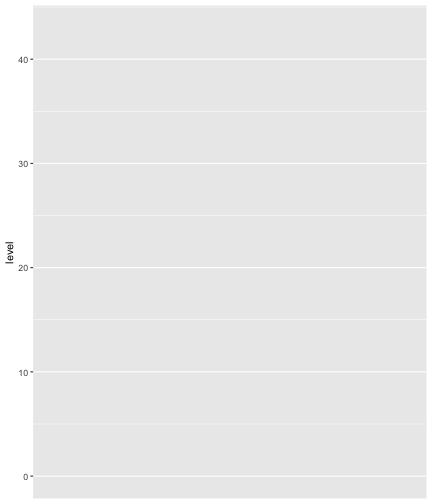<!-- --> ]] --- class: split-40 count: false .column[.content[ ```r ggplot(ball_bearings) + aes(y = level) + * aes(x = x_position) ``` ]] .column[.content[ 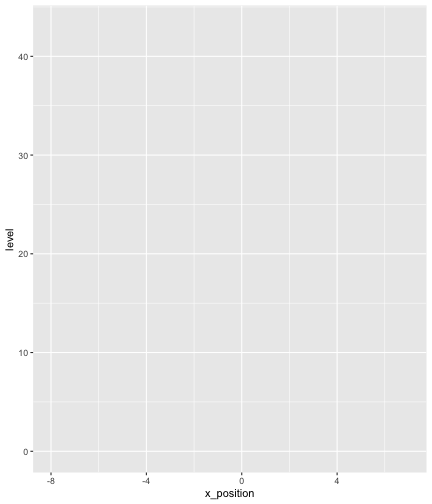<!-- --> ]] --- class: split-40 count: false .column[.content[ ```r ggplot(ball_bearings) + aes(y = level) + aes(x = x_position) + * scale_y_reverse() ``` ]] .column[.content[ 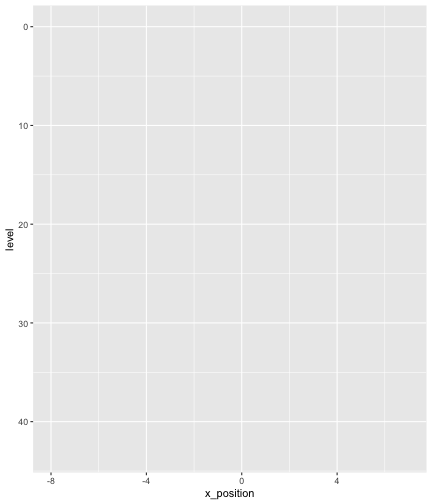<!-- --> ]] --- class: split-40 count: false .column[.content[ ```r ggplot(ball_bearings) + aes(y = level) + aes(x = x_position) + scale_y_reverse() + * aes(group = unit_id) ``` ]] .column[.content[ 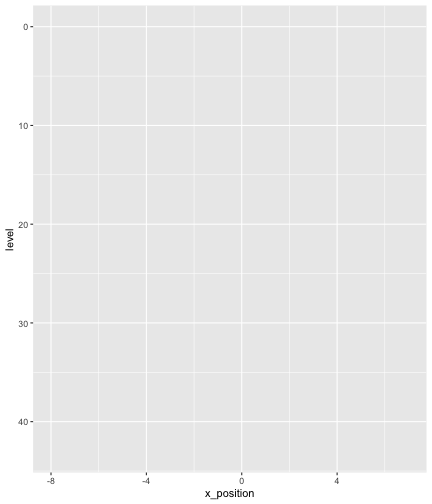<!-- --> ]] --- class: split-40 count: false .column[.content[ ```r ggplot(ball_bearings) + aes(y = level) + aes(x = x_position) + scale_y_reverse() + aes(group = unit_id) + * geom_point(data = walls, * aes(x = unit_id, alpha = transparent), * col = "grey30", size = peg_size) ``` ]] .column[.content[ 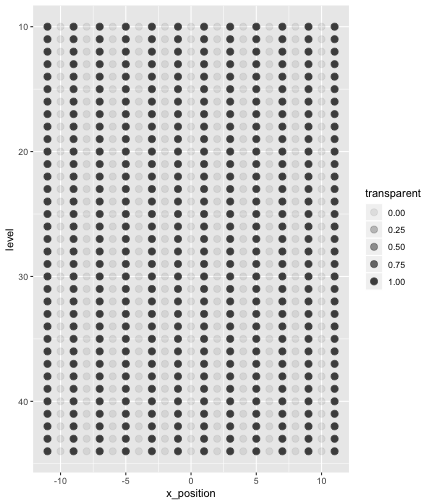<!-- --> ]] --- class: split-40 count: false .column[.content[ ```r ggplot(ball_bearings) + aes(y = level) + aes(x = x_position) + scale_y_reverse() + aes(group = unit_id) + geom_point(data = walls, aes(x = unit_id, alpha = transparent), col = "grey30", size = peg_size) + * geom_point(data = pegs, * aes(x = unit_id, alpha = transparent), * col = "grey30", size = peg_size) ``` ]] .column[.content[ 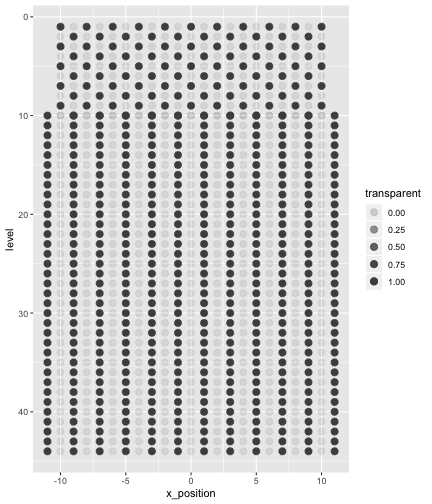<!-- --> ]] --- class: split-40 count: false .column[.content[ ```r ggplot(ball_bearings) + aes(y = level) + aes(x = x_position) + scale_y_reverse() + aes(group = unit_id) + geom_point(data = walls, aes(x = unit_id, alpha = transparent), col = "grey30", size = peg_size) + geom_point(data = pegs, aes(x = unit_id, alpha = transparent), col = "grey30", size = peg_size) + * geom_segment(x = -sqrt(n), xend = -1.5, * y = 0, yend = 0) ``` ]] .column[.content[ 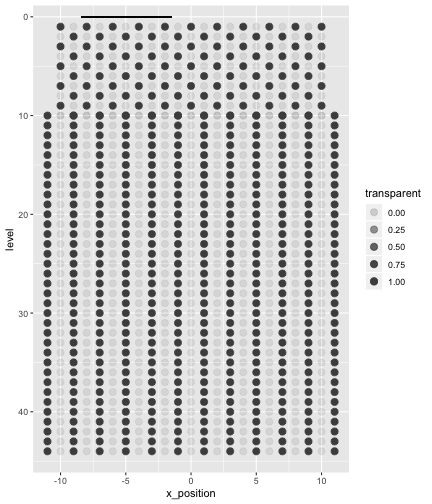<!-- --> ]] --- class: split-40 count: false .column[.content[ ```r ggplot(ball_bearings) + aes(y = level) + aes(x = x_position) + scale_y_reverse() + aes(group = unit_id) + geom_point(data = walls, aes(x = unit_id, alpha = transparent), col = "grey30", size = peg_size) + geom_point(data = pegs, aes(x = unit_id, alpha = transparent), col = "grey30", size = peg_size) + geom_segment(x = -sqrt(n), xend = -1.5, y = 0, yend = 0) + * geom_segment(x = sqrt(n), xend = 1.5, * y = 0, yend = 0) ``` ]] .column[.content[ 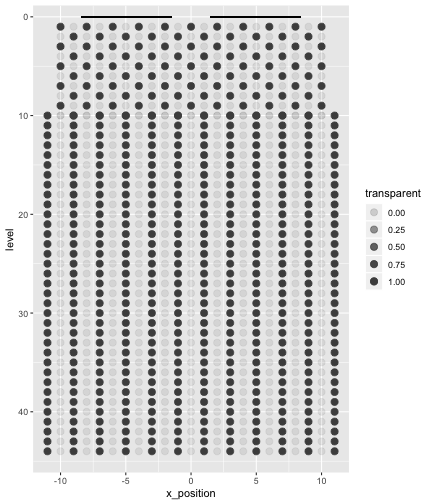<!-- --> ]] --- class: split-40 count: false .column[.content[ ```r ggplot(ball_bearings) + aes(y = level) + aes(x = x_position) + scale_y_reverse() + aes(group = unit_id) + geom_point(data = walls, aes(x = unit_id, alpha = transparent), col = "grey30", size = peg_size) + geom_point(data = pegs, aes(x = unit_id, alpha = transparent), col = "grey30", size = peg_size) + geom_segment(x = -sqrt(n), xend = -1.5, y = 0, yend = 0) + geom_segment(x = sqrt(n), xend = 1.5, y = 0, yend = 0) + * geom_abline(intercept = 1.5, * slope = -1) ``` ]] .column[.content[ 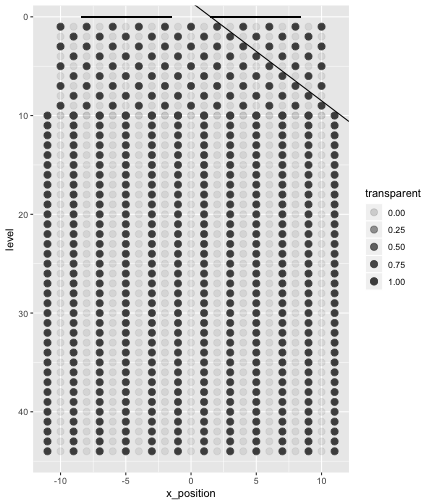<!-- --> ]] --- class: split-40 count: false .column[.content[ ```r ggplot(ball_bearings) + aes(y = level) + aes(x = x_position) + scale_y_reverse() + aes(group = unit_id) + geom_point(data = walls, aes(x = unit_id, alpha = transparent), col = "grey30", size = peg_size) + geom_point(data = pegs, aes(x = unit_id, alpha = transparent), col = "grey30", size = peg_size) + geom_segment(x = -sqrt(n), xend = -1.5, y = 0, yend = 0) + geom_segment(x = sqrt(n), xend = 1.5, y = 0, yend = 0) + geom_abline(intercept = 1.5, slope = -1) + * geom_abline(intercept = 1.5, * slope = 1) ``` ]] .column[.content[ 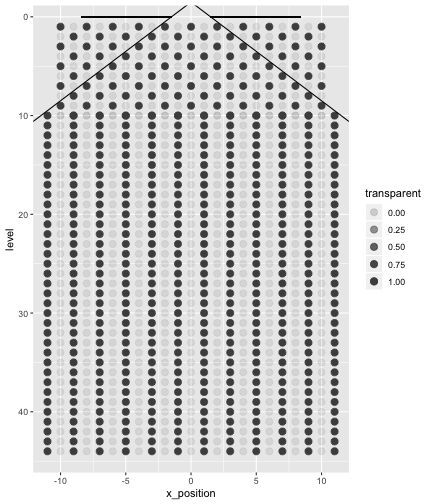<!-- --> ]] --- class: split-40 count: false .column[.content[ ```r ggplot(ball_bearings) + aes(y = level) + aes(x = x_position) + scale_y_reverse() + aes(group = unit_id) + geom_point(data = walls, aes(x = unit_id, alpha = transparent), col = "grey30", size = peg_size) + geom_point(data = pegs, aes(x = unit_id, alpha = transparent), col = "grey30", size = peg_size) + geom_segment(x = -sqrt(n), xend = -1.5, y = 0, yend = 0) + geom_segment(x = sqrt(n), xend = 1.5, y = 0, yend = 0) + geom_abline(intercept = 1.5, slope = -1) + geom_abline(intercept = 1.5, slope = 1) + * annotate(geom = "tile", * height = 2, width = 2, * x = 0 , y = -1.5) ``` ]] .column[.content[ 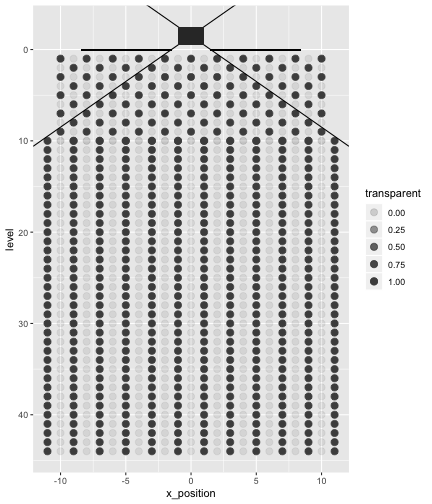<!-- --> ]] --- class: split-40 count: false .column[.content[ ```r ggplot(ball_bearings) + aes(y = level) + aes(x = x_position) + scale_y_reverse() + aes(group = unit_id) + geom_point(data = walls, aes(x = unit_id, alpha = transparent), col = "grey30", size = peg_size) + geom_point(data = pegs, aes(x = unit_id, alpha = transparent), col = "grey30", size = peg_size) + geom_segment(x = -sqrt(n), xend = -1.5, y = 0, yend = 0) + geom_segment(x = sqrt(n), xend = 1.5, y = 0, yend = 0) + geom_abline(intercept = 1.5, slope = -1) + geom_abline(intercept = 1.5, slope = 1) + annotate(geom = "tile", height = 2, width = 2, x = 0 , y = -1.5) + * annotate(geom = "tile", * height = 2, width = 1.75, * x = 0 , y = -1.5, fill = "white") ``` ]] .column[.content[ 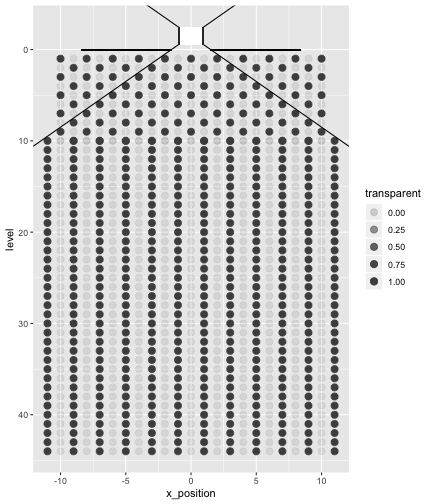<!-- --> ]] --- class: split-40 count: false .column[.content[ ```r ggplot(ball_bearings) + aes(y = level) + aes(x = x_position) + scale_y_reverse() + aes(group = unit_id) + geom_point(data = walls, aes(x = unit_id, alpha = transparent), col = "grey30", size = peg_size) + geom_point(data = pegs, aes(x = unit_id, alpha = transparent), col = "grey30", size = peg_size) + geom_segment(x = -sqrt(n), xend = -1.5, y = 0, yend = 0) + geom_segment(x = sqrt(n), xend = 1.5, y = 0, yend = 0) + geom_abline(intercept = 1.5, slope = -1) + geom_abline(intercept = 1.5, slope = 1) + annotate(geom = "tile", height = 2, width = 2, x = 0 , y = -1.5) + annotate(geom = "tile", height = 2, width = 1.75, x = 0 , y = -1.5, fill = "white") + * geom_rect(data = ball_bearings_collect, * mapping = aes(xmin = x_position - .35, * xmax = x_position + .35, * ymax = max(ball_bearings$level) + 1 - x_position_count*1.5, * ymin = max(ball_bearings$level) + 1, * group = x_position, * y = NULL, x = NULL), * fill = "darkgrey") ``` ]] .column[.content[ 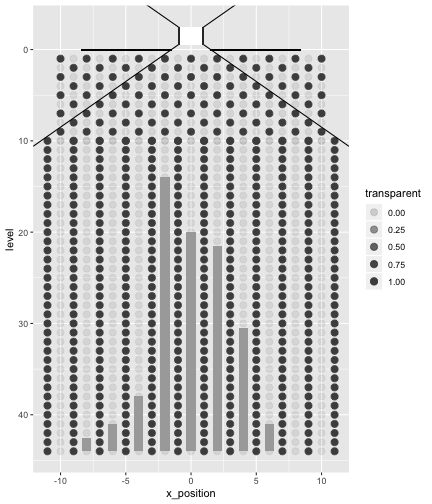<!-- --> ]] --- class: split-40 count: false .column[.content[ ```r ggplot(ball_bearings) + aes(y = level) + aes(x = x_position) + scale_y_reverse() + aes(group = unit_id) + geom_point(data = walls, aes(x = unit_id, alpha = transparent), col = "grey30", size = peg_size) + geom_point(data = pegs, aes(x = unit_id, alpha = transparent), col = "grey30", size = peg_size) + geom_segment(x = -sqrt(n), xend = -1.5, y = 0, yend = 0) + geom_segment(x = sqrt(n), xend = 1.5, y = 0, yend = 0) + geom_abline(intercept = 1.5, slope = -1) + geom_abline(intercept = 1.5, slope = 1) + annotate(geom = "tile", height = 2, width = 2, x = 0 , y = -1.5) + annotate(geom = "tile", height = 2, width = 1.75, x = 0 , y = -1.5, fill = "white") + geom_rect(data = ball_bearings_collect, mapping = aes(xmin = x_position - .35, xmax = x_position + .35, ymax = max(ball_bearings$level) + 1 - x_position_count*1.5, ymin = max(ball_bearings$level) + 1, group = x_position, y = NULL, x = NULL), fill = "darkgrey") + * geom_point(size = ball_bearings_size, * col = "steelblue") ``` ]] .column[.content[ 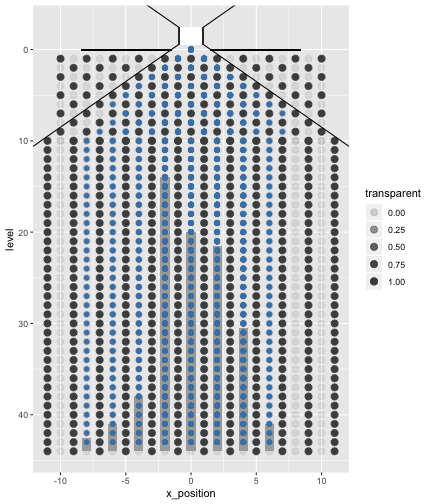<!-- --> ]] --- class: split-40 count: false .column[.content[ ```r ggplot(ball_bearings) + aes(y = level) + aes(x = x_position) + scale_y_reverse() + aes(group = unit_id) + geom_point(data = walls, aes(x = unit_id, alpha = transparent), col = "grey30", size = peg_size) + geom_point(data = pegs, aes(x = unit_id, alpha = transparent), col = "grey30", size = peg_size) + geom_segment(x = -sqrt(n), xend = -1.5, y = 0, yend = 0) + geom_segment(x = sqrt(n), xend = 1.5, y = 0, yend = 0) + geom_abline(intercept = 1.5, slope = -1) + geom_abline(intercept = 1.5, slope = 1) + annotate(geom = "tile", height = 2, width = 2, x = 0 , y = -1.5) + annotate(geom = "tile", height = 2, width = 1.75, x = 0 , y = -1.5, fill = "white") + geom_rect(data = ball_bearings_collect, mapping = aes(xmin = x_position - .35, xmax = x_position + .35, ymax = max(ball_bearings$level) + 1 - x_position_count*1.5, ymin = max(ball_bearings$level) + 1, group = x_position, y = NULL, x = NULL), fill = "darkgrey") + geom_point(size = ball_bearings_size, col = "steelblue") + * coord_equal() ``` ]] .column[.content[ 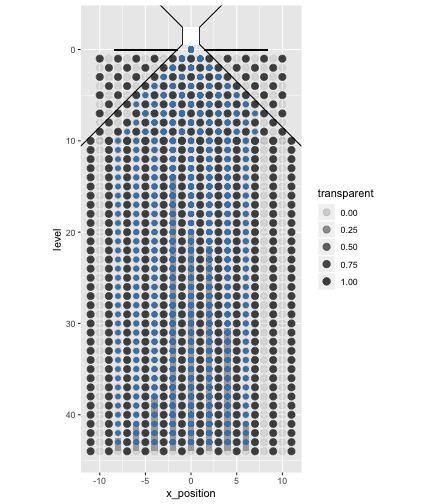<!-- --> ]] --- class: split-40 count: false .column[.content[ ```r ggplot(ball_bearings) + aes(y = level) + aes(x = x_position) + scale_y_reverse() + aes(group = unit_id) + geom_point(data = walls, aes(x = unit_id, alpha = transparent), col = "grey30", size = peg_size) + geom_point(data = pegs, aes(x = unit_id, alpha = transparent), col = "grey30", size = peg_size) + geom_segment(x = -sqrt(n), xend = -1.5, y = 0, yend = 0) + geom_segment(x = sqrt(n), xend = 1.5, y = 0, yend = 0) + geom_abline(intercept = 1.5, slope = -1) + geom_abline(intercept = 1.5, slope = 1) + annotate(geom = "tile", height = 2, width = 2, x = 0 , y = -1.5) + annotate(geom = "tile", height = 2, width = 1.75, x = 0 , y = -1.5, fill = "white") + geom_rect(data = ball_bearings_collect, mapping = aes(xmin = x_position - .35, xmax = x_position + .35, ymax = max(ball_bearings$level) + 1 - x_position_count*1.5, ymin = max(ball_bearings$level) + 1, group = x_position, y = NULL, x = NULL), fill = "darkgrey") + geom_point(size = ball_bearings_size, col = "steelblue") + coord_equal() + * geom_hline(yintercept = stop_level, * linetype = "dotted") ``` ]] .column[.content[ 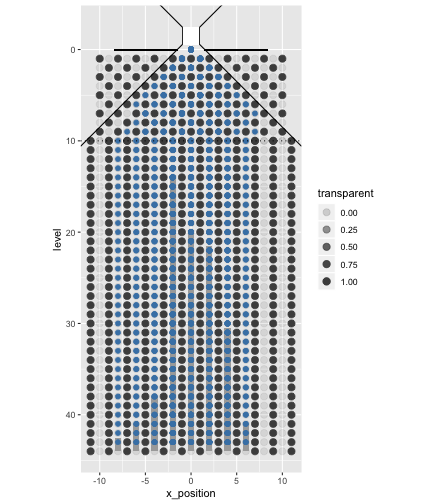<!-- --> ]] --- class: split-40 count: false .column[.content[ ```r ggplot(ball_bearings) + aes(y = level) + aes(x = x_position) + scale_y_reverse() + aes(group = unit_id) + geom_point(data = walls, aes(x = unit_id, alpha = transparent), col = "grey30", size = peg_size) + geom_point(data = pegs, aes(x = unit_id, alpha = transparent), col = "grey30", size = peg_size) + geom_segment(x = -sqrt(n), xend = -1.5, y = 0, yend = 0) + geom_segment(x = sqrt(n), xend = 1.5, y = 0, yend = 0) + geom_abline(intercept = 1.5, slope = -1) + geom_abline(intercept = 1.5, slope = 1) + annotate(geom = "tile", height = 2, width = 2, x = 0 , y = -1.5) + annotate(geom = "tile", height = 2, width = 1.75, x = 0 , y = -1.5, fill = "white") + geom_rect(data = ball_bearings_collect, mapping = aes(xmin = x_position - .35, xmax = x_position + .35, ymax = max(ball_bearings$level) + 1 - x_position_count*1.5, ymin = max(ball_bearings$level) + 1, group = x_position, y = NULL, x = NULL), fill = "darkgrey") + geom_point(size = ball_bearings_size, col = "steelblue") + coord_equal() + geom_hline(yintercept = stop_level, linetype = "dotted") + * scale_alpha_continuous(range = c(0, 1), guide = F) ``` ]] .column[.content[ 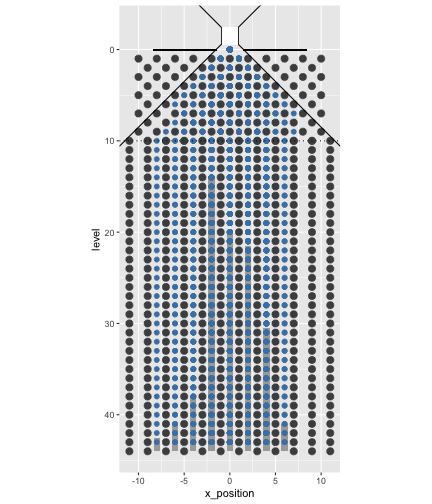<!-- --> ]] --- class: split-40 count: false .column[.content[ ```r ggplot(ball_bearings) + aes(y = level) + aes(x = x_position) + scale_y_reverse() + aes(group = unit_id) + geom_point(data = walls, aes(x = unit_id, alpha = transparent), col = "grey30", size = peg_size) + geom_point(data = pegs, aes(x = unit_id, alpha = transparent), col = "grey30", size = peg_size) + geom_segment(x = -sqrt(n), xend = -1.5, y = 0, yend = 0) + geom_segment(x = sqrt(n), xend = 1.5, y = 0, yend = 0) + geom_abline(intercept = 1.5, slope = -1) + geom_abline(intercept = 1.5, slope = 1) + annotate(geom = "tile", height = 2, width = 2, x = 0 , y = -1.5) + annotate(geom = "tile", height = 2, width = 1.75, x = 0 , y = -1.5, fill = "white") + geom_rect(data = ball_bearings_collect, mapping = aes(xmin = x_position - .35, xmax = x_position + .35, ymax = max(ball_bearings$level) + 1 - x_position_count*1.5, ymin = max(ball_bearings$level) + 1, group = x_position, y = NULL, x = NULL), fill = "darkgrey") + geom_point(size = ball_bearings_size, col = "steelblue") + coord_equal() + geom_hline(yintercept = stop_level, linetype = "dotted") + scale_alpha_continuous(range = c(0, 1), guide = F) + * theme_void() ``` ]] .column[.content[ 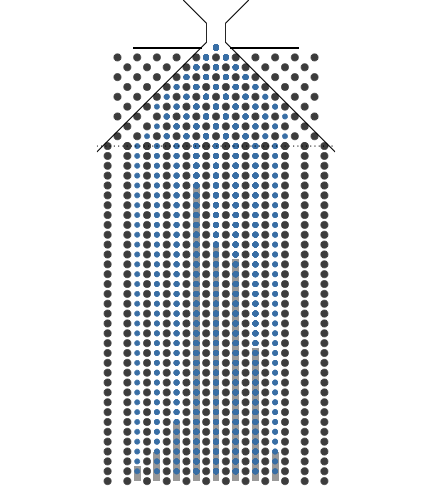<!-- --> ]] --- class: split-40 count: false .column[.content[ ```r ggplot(ball_bearings) + aes(y = level) + aes(x = x_position) + scale_y_reverse() + aes(group = unit_id) + geom_point(data = walls, aes(x = unit_id, alpha = transparent), col = "grey30", size = peg_size) + geom_point(data = pegs, aes(x = unit_id, alpha = transparent), col = "grey30", size = peg_size) + geom_segment(x = -sqrt(n), xend = -1.5, y = 0, yend = 0) + geom_segment(x = sqrt(n), xend = 1.5, y = 0, yend = 0) + geom_abline(intercept = 1.5, slope = -1) + geom_abline(intercept = 1.5, slope = 1) + annotate(geom = "tile", height = 2, width = 2, x = 0 , y = -1.5) + annotate(geom = "tile", height = 2, width = 1.75, x = 0 , y = -1.5, fill = "white") + geom_rect(data = ball_bearings_collect, mapping = aes(xmin = x_position - .35, xmax = x_position + .35, ymax = max(ball_bearings$level) + 1 - x_position_count*1.5, ymin = max(ball_bearings$level) + 1, group = x_position, y = NULL, x = NULL), fill = "darkgrey") + geom_point(size = ball_bearings_size, col = "steelblue") + coord_equal() + geom_hline(yintercept = stop_level, linetype = "dotted") + scale_alpha_continuous(range = c(0, 1), guide = F) + theme_void() -> g#<< ``` ]] .column[.content[ ]] --- class: split-40 count: false .column[.content[ ```r *g + * gganimate::transition_time(time = time) + * gganimate::shadow_wake(wake_length = .05) + * gganimate::ease_aes("bounce-in-out") ``` ]] .column[.content[ 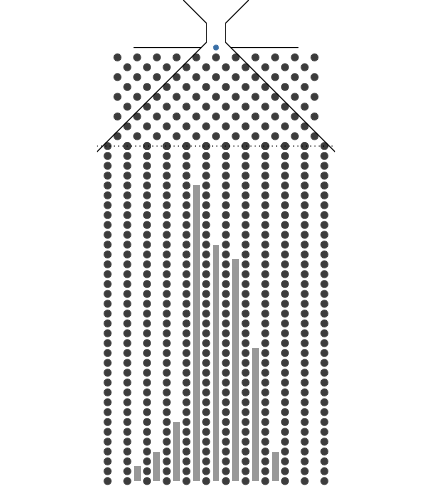<!-- --> ]] --- # Binomial distribution Now the fast way to simulating... --- class: split-40 count: false .column[.content[ ```r *set.seed(1999) ``` ]] .column[.content[ ]] --- class: split-40 count: false .column[.content[ ```r set.seed(1999) *n_balls <- 1000 ``` ]] .column[.content[ ]] --- class: split-40 count: false .column[.content[ ```r set.seed(1999) n_balls <- 1000 *n_perturb <- 200 ``` ]] .column[.content[ ]] --- class: split-40 count: false .column[.content[ ```r set.seed(1999) n_balls <- 1000 n_perturb <- 200 *crossing(ball_id = 1:n_balls, * 1:n_perturb) ``` ]] .column[.content[ ``` # A tibble: 200,000 x 2 ball_id `1:n_perturb` <int> <int> 1 1 1 2 1 2 3 1 3 4 1 4 5 1 5 6 1 6 7 1 7 8 1 8 9 1 9 10 1 10 # … with 199,990 more rows ``` ]] --- class: split-40 count: false .column[.content[ ```r set.seed(1999) n_balls <- 1000 n_perturb <- 200 crossing(ball_id = 1:n_balls, 1:n_perturb) %>% * mutate(perturbation = * sample(c(-1,1), * n(), * replace = T)) ``` ]] .column[.content[ ``` # A tibble: 200,000 x 3 ball_id `1:n_perturb` perturbation <int> <int> <dbl> 1 1 1 1 2 1 2 1 3 1 3 -1 4 1 4 -1 5 1 5 1 6 1 6 1 7 1 7 1 8 1 8 1 9 1 9 1 10 1 10 1 # … with 199,990 more rows ``` ]] --- class: split-40 count: false .column[.content[ ```r set.seed(1999) n_balls <- 1000 n_perturb <- 200 crossing(ball_id = 1:n_balls, 1:n_perturb) %>% mutate(perturbation = sample(c(-1,1), n(), replace = T)) %>% * group_by(ball_id) ``` ]] .column[.content[ ``` # A tibble: 200,000 x 3 # Groups: ball_id [1,000] ball_id `1:n_perturb` perturbation <int> <int> <dbl> 1 1 1 1 2 1 2 1 3 1 3 -1 4 1 4 -1 5 1 5 1 6 1 6 1 7 1 7 1 8 1 8 1 9 1 9 1 10 1 10 1 # … with 199,990 more rows ``` ]] --- class: split-40 count: false .column[.content[ ```r set.seed(1999) n_balls <- 1000 n_perturb <- 200 crossing(ball_id = 1:n_balls, 1:n_perturb) %>% mutate(perturbation = sample(c(-1,1), n(), replace = T)) %>% group_by(ball_id) %>% * summarise(x_position = * sum(perturbation)) ``` ]] .column[.content[ ``` # A tibble: 1,000 x 2 ball_id x_position <int> <dbl> 1 1 30 2 2 20 3 3 12 4 4 -8 5 5 -8 6 6 10 7 7 20 8 8 12 9 9 4 10 10 24 # … with 990 more rows ``` ]] --- class: split-40 count: false .column[.content[ ```r set.seed(1999) n_balls <- 1000 n_perturb <- 200 crossing(ball_id = 1:n_balls, 1:n_perturb) %>% mutate(perturbation = sample(c(-1,1), n(), replace = T)) %>% group_by(ball_id) %>% summarise(x_position = sum(perturbation)) %>% * ggplot() ``` ]] .column[.content[ <!-- --> ]] --- class: split-40 count: false .column[.content[ ```r set.seed(1999) n_balls <- 1000 n_perturb <- 200 crossing(ball_id = 1:n_balls, 1:n_perturb) %>% mutate(perturbation = sample(c(-1,1), n(), replace = T)) %>% group_by(ball_id) %>% summarise(x_position = sum(perturbation)) %>% ggplot() + * aes(x = x_position) ``` ]] .column[.content[ 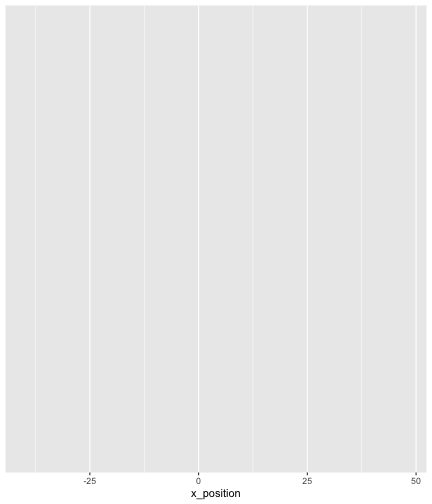<!-- --> ]] --- class: split-40 count: false .column[.content[ ```r set.seed(1999) n_balls <- 1000 n_perturb <- 200 crossing(ball_id = 1:n_balls, 1:n_perturb) %>% mutate(perturbation = sample(c(-1,1), n(), replace = T)) %>% group_by(ball_id) %>% summarise(x_position = sum(perturbation)) %>% ggplot() + aes(x = x_position) + * geom_histogram(binwidth = 2, * col = "lightgrey", * fill = "steelblue", * alpha = .7) ``` ]] .column[.content[ 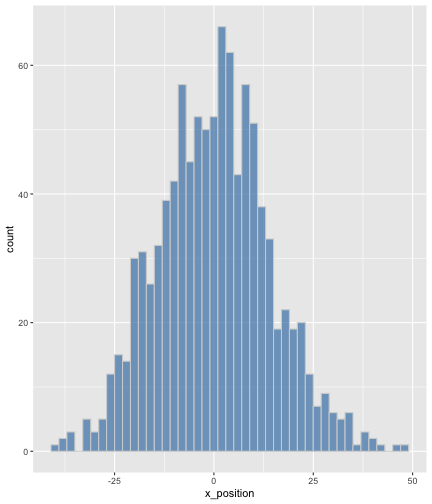<!-- --> ]] --- class: split-40 count: false .column[.content[ ```r set.seed(1999) n_balls <- 1000 n_perturb <- 200 crossing(ball_id = 1:n_balls, 1:n_perturb) %>% mutate(perturbation = sample(c(-1,1), n(), replace = T)) %>% group_by(ball_id) %>% summarise(x_position = sum(perturbation)) %>% ggplot() + aes(x = x_position) + geom_histogram(binwidth = 2, col = "lightgrey", fill = "steelblue", alpha = .7) + * theme_minimal() ``` ]] .column[.content[ 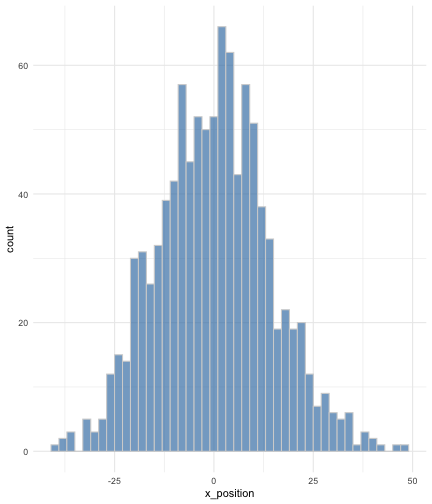<!-- --> ]] <style type="text/css"> .remark-code{line-height: 1.5; font-size: 50%} </style>